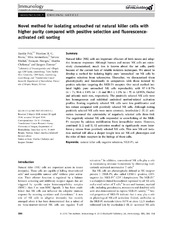Novel method for isolating untouched rat natural killer cells with higher purity compared with positive selection and fluorescenceactivated cell sorting
Poli, Aurélie; Brons, Nicolaas H.C.; Ammerlaan, Wim; Michel, Tatiana; Hentges, François; Chekenya, Martha; Zimmer, Jacques
Peer reviewed, Journal article
Published version
Permanent lenke
https://hdl.handle.net/1956/7865Utgivelsesdato
2010-11Metadata
Vis full innførselSamlinger
Originalversjon
https://doi.org/10.1111/j.1365-2567.2010.03312.xSammendrag
Natural killer (NK) cells are important effectors of both innate and adaptive immune responses. Although human and mouse NK cells are extensively characterized, much less is known about the rat cells, partly because of the current lack of reliable isolation techniques. We aimed to develop a method for isolating highly pure ‘untouched’ rat NK cells by negative selection from splenocytes. Thereafter, we characterized them phenotypically and functionally in comparison with those isolated by positive selection targeting the NKR-P1 receptor. Our novel method isolated highly pure untouched NK cells reproducibly with 97 ± 0 7% (n = 7), 96 6 ± 0 8% (n = 3) and 88 3 ± 1 5% (n = 9) in LEWIS, Fischer and athymic nude rats, respectively. The positively selected NK cells were less homogeneous and exhibited undesired method-related activation profiles. Resting negatively selected NK cells were less proliferative and less robust compared with positively selected NK cells. Although resting positively selected NK cells were more cytotoxic, interleukin-2 (IL-2) activation increased the cytotoxicity of negatively selected cells three-fold. The negatively selected NK cells responded to cross-linking of the NKRP1 receptor by calcium mobilization from intracellular stores. However, combined IL-2 and IL-12 activation resulted in significantly more interferon- c release from positively selected NK cells. This new NK-cell isolation method will allow a deeper insight into rat NK-cell phenotypes and the roles of their receptors in the biology of these cells.
